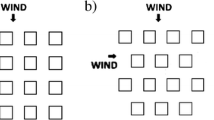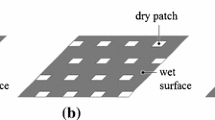Abstract
We performed a series of wind-tunnel experiments under neutral conditions in order to create a comprehensive database of scalar transfer coefficients for street surfaces using regular block arrays representing an urban environment. The objective is to clarify the geometric dependence of scalar transfer phenomena on rough surfaces. In addition, the datasets we have obtained are necessary to improve the modelling of scalar transfer used for computational simulations of urban environments; further, we can validate the results obtained by numerical simulations. We estimated the scalar transfer coefficients using the salinity method. The various configurations of the block arrays were designed to be similar to those used in a previous experiment to determine the total drag force acting on arrays. Our results are summarized as follows: first, the results for cubical arrays showed that the transfer coefficients for staggered and square layouts varied with the roughness packing density. The results for the staggered layout showed the possibility that the mixing effect of air can be enhanced for the mid-range values of the packing density. Secondly, the transfer coefficients for arrays with blocks of non-uniform heights were smaller than those for arrays with blocks of uniform height under conditions of low packing density; however, as the packing density increased, the opposite tendency was observed. Thirdly, the randomness of rotation angles of the blocks in the array led to increasing values of the transfer coefficients under sparse packing density conditions when compared with those for cubical arrays.
Similar content being viewed by others
References
Barlow JF, Belcher SE (2002) A wind tunnel model for quantifying fluxes in the urban boundary layer. Boundary-Layer Meteorol 104: 131–150
Barlow JF, Harman IN, Belcher SE (2004) Scalar fluxes from urban street canyons. Part 1: laboratory simulation. Boundary-Layer Meteorol 113: 369–385
Boppana VB, Xie ZT, Castro IP (2010) Large-eddy simulation of dispersion from surface sources in arrays of obstacles. Boundary-Layer Meteorol 135: 433–454
Bransford S, Coceal O, Thomas TG, Belcher SE (2011) Dispersion of a point-source release of a passive scalar through an urban-like array for different wind directions. Boundary-Layer Meteorol 139: 367–394
Cai XM, Barlow JF, Belcher SE (2008) Dispersion and transfer of passive scalars in and above street canyons–large-eddy simulations. Atmos Environ 42: 5885–5895
Cheng H, Castro IP (2002) Near wall flow over urban-like roughness. Boundary-Layer Meteorol 104: 229–259
Cheng WC, Liu CH (2011) Large-eddy simulation of flow and pollutant transports in and above two-dimensional idealized street canyons. Boundary-Layer Meteorol 139: 411–437
Coceal O, Thomas TG, Castro IP, Belcher SE (2006) Mean flow and turbulence statistics over groups of urban-like cubical obstacles. Boundary-Layer Meteorol 121: 491–519
Coceal O, Thomas TG, Belcher SE (2007) Spatial variability of flow statistics within regular building arrays. Boundary-Layer Meteorol 125: 537–552
Counihan J (1971) Wind tunnel determination of the roughness length as a function of the fetch and the roughness density of three-dimensional roughness elements. Atmos Environ 5: 637–642
Farell C, Iyenger AKS (1999) Experiments on the wind tunnel simulation of atmospheric boundary layers. J Wind Eng Ind Aerodyn 79: 11–35
Hagishima A, Tanimoto J, Narita K-I (2005) Intercomparisons of experimental convective heat transfer coefficients and mass transfer coefficients of urban surfaces. Boundary-Layer Meteorol 117: 551–576
Hagishima A, Tanimoto J, Nagayama K, Meno S (2009) Aerodynamic parameters of regular arrays of rectangular blocks with various geometries. Boundary-Layer Meteorol 132: 315–337
Incropera F, DeWitte D (2002) Fundamentals of heat and mass transfer, 5th edn. Wiley, New York
Iyenger AKS, Farell C (2011) Experimental issues in atmospheric boundary layer simulations: roughness length and integral length scale determination. J Wind Eng Ind Aerodyn 89: 1059–1080
Li X, Liu C, Leung DYC (2008) Large-eddy simulation of flow and pollutant dispersion in high-aspect-ratio urban street canyons with wall model. Boundary-Layer Meteorol 129: 249–268
Li X, Britter RE, Koh TY, Norford KK, Liu CH, Entekhabi D, Leung DYC (2010) Large-eddy simulation of flow and pollutant transport in urban street canyons with ground heating. Boundary-Layer Meteorol 137: 187–204
Michioka T, Sato A, Takimoto H, Kanda M (2010) Large-eddy simulation for the mechanism of pollutant removal from a two-dimensional street canyon. Boundary-layer Meteorol 138: 195–213
Narita KI (2007) Experimental study of the transfer velocity for urban surfaces with a water evaporation method. Boundary-Layer Meteorol 122: 293–320
Oke TR (1988) Street design and urban canopy layer climate. Energy Build 11: 103–113
Pascheke F, Barlow JF, Robins A (2008) Wind-tunnel modelling of dispersion from a scalar area source in urban-like roughness. Boundary-Layer Meteorol 126: 103–124
Raupach MR, Thom AS, Edward I (1980) A wind-tunnel study of turbulent flow close to regularly arrayed rough surfaces. Boundary-Layer Meteorol 18: 373–397
Snyder WH, Castro IP (2002) The critical Reynolds number for rough-wall boundary layers. J Wind Eng Ind Aerodyn 90: 41–54
Uehara K, Wakamatsu S, Ooka R (2003) Studies on critical Reynolds number indices for wind-tunnel experiments on flow within urban areas. Boundary-Layer Meteorol 107: 353–370
Wooding RA, Bradley EF, Marshall JK (1973) Drag due to regular arrays of roughness elements of varying geometry. Boundary-Layer Meteorol 5: 285–308
Xie ZT, Coceal O, Castro IP (2008) Large-eddy simulation of flows over random urban-like obstacles. Boundary-Layer Meteorol 129: 1–23
Zaki SA, Haghishima A, Tanimoto J, Ikegaya N (2011) Aerodynamic parameters of urban building arrays with random geometries. Boundary-Layer Meteorol 138: 99–120
Author information
Authors and Affiliations
Corresponding author
Rights and permissions
About this article
Cite this article
Ikegaya, N., Hagishima, A., Tanimoto, J. et al. Geometric Dependence of the Scalar Transfer Efficiency over Rough Surfaces. Boundary-Layer Meteorol 143, 357–377 (2012). https://doi.org/10.1007/s10546-012-9698-5
Received:
Accepted:
Published:
Issue Date:
DOI: https://doi.org/10.1007/s10546-012-9698-5




